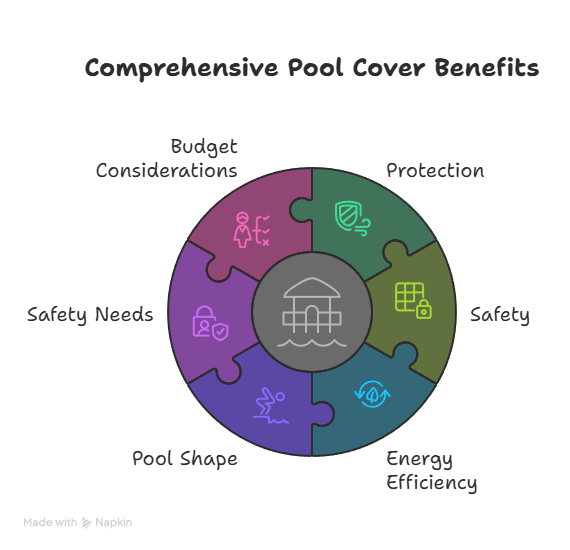Pool Cover: Essential Protection for Your Swimming Pool InvestmentPool Cover: Essential Protection for Your Swimming Pool Investment
A pool cover is a vital accessory that protects your swimming pool, enhances safety, and provides energy efficiency benefits. Choosing the right cover depends on your pool’s shape, your safety needs, and your budget considerations.

Key Takeaways:
- Not all pool covers provide safety features; only specific types can bear weight
- Rectangular pools work best with standard covers, while curved pools may need custom solutions
- Quality covers offer significant energy savings and reduce chemical use
- Different cover types have varying installation requirements and maintenance needs
- A proper swimming pool winter cover can protect your investment during off-seasons
What Are Pool Covers and Why Do You Need One?
Pool covers are protective barriers that shield your swimming pool when not in use. They serve multiple purposes: preventing debris accumulation, maintaining water temperature, reducing evaporation, enhancing safety, and lowering maintenance costs.
Do you know that uncovered pools can lose up to 30% of their heat overnight? A good cover acts as your pool’s shield against heat loss, dirt, leaves, and potential accidents.
Pool Cover Compatibility with Different Swimming Pool Shapes
Can pool covers work with any pool shape? Yes, but with some important considerations:
- Rectangular pools are ideal for standard pool covers
- Curved pools may not accommodate covers on rollers
- Irregularly shaped pools make some cover types impractical
- Custom solutions are available for unique pool designs
While manufacturers can create a bespoke pool cover to fit almost any shape, functionality may vary. For example, a swimming pool cover roller system works most efficiently with rectangular pools.
Types of Pool Covers Explained
There are several types of pool covers available, each with distinct features:
- Thermal Blankets: Focus on heat retention and energy savings but offer no safety features
- Pet and Child Safety Covers: Designed to temporarily support weight, preventing accidents
- PoolDeck Slatted Automatic Pool Covers: Combine convenience with style and automated operation
- Automatic Vinyl Safety Covers: Provide complete protection with both safety features and automation
- Basic Tarps: The most basic option with minimal benefits compared to specialized covers
For families with children or pets, a swimming pool safety cover provides essential protection against accidents.
Safety Features of Different Pool Cover Types
Not all pool covers are created equal when it comes to safety:
- Thermal blankets will NOT support weight and are not safety devices
- Automatic covers and Pet and Child Safety Covers are approved safety devices
- Safety covers can temporarily bear weight but not for extended periods
- Excessive weight can damage even safety-rated covers
Remember: Even with a safety cover, proper supervision around pools remains essential!
Benefits of Investing in Quality Pool Covers
Quality swimming pool covers for sale offer numerous advantages:
| Benefit | Description |
|---|---|
| Energy Savings | Reduces heating costs by up to 70% |
| Water Conservation | Minimizes evaporation by up to 95% |
| Chemical Reduction | Decreases chemical use by 35-60% |
| Cleaner Water | Prevents debris, leaves, and dirt contamination |
| Extended Season | Maintains warmer temperatures for longer swimming seasons |
| Enhanced Safety | Provides protection for children and pets (safety models only) |
Installation Process for Different Pool Cover Types
Installation complexity varies by cover type:
- Thermal blankets: DIY-friendly, simply unroll over the pool
- Safety covers: Require proper anchoring systems and often professional installation
- Automatic covers: Need professional installation with electrical components
- Measurement requirements must be precise, especially for custom pools
For complex installations, consulting with swimming pool covers near me professionals ensures proper fit and function.
Maintenance and Care for Pool Covers
Proper maintenance extends your cover’s lifespan:
- Clean monthly with mild soap and water
- Remove standing water to prevent damage
- Store properly during off-seasons
- Prepare specifically for winter with a dedicated swimming pool winter cover
- Repair small tears immediately before they become major issues
Cost Considerations and Long-Term Value
Initial investment varies significantly:
- Basic covers: $100-$300
- Thermal blankets: $300-$800
- Safety covers: $1,000-$3,000
- Automatic systems: $5,000-$15,000+
While premium options have higher upfront costs, they typically last 7-10 years with proper care and provide significant savings on heating, chemicals, and water—often paying for themselves within 2-3 years.
Choosing the Right Pool Cover for Your Needs
When selecting a cover, consider:
- Safety requirements: Do you need child/pet protection?
- Pool shape and size: Is your pool standard or custom-shaped?
- Climate conditions: Do you need heavy-duty winter protection?
- Budget vs. features: What’s your priority—initial cost or long-term savings?
- Maintenance commitment: How much time can you dedicate to cover care?
Don’t forget to check if your pool has a swimming pool sump cover that might affect your pool cover installation.
Conclusion
A quality pool cover is an investment that delivers safety, savings, and convenience. By selecting the right type for your specific needs, you’ll enjoy cleaner water, lower maintenance costs, and potentially enhanced safety for years to come.